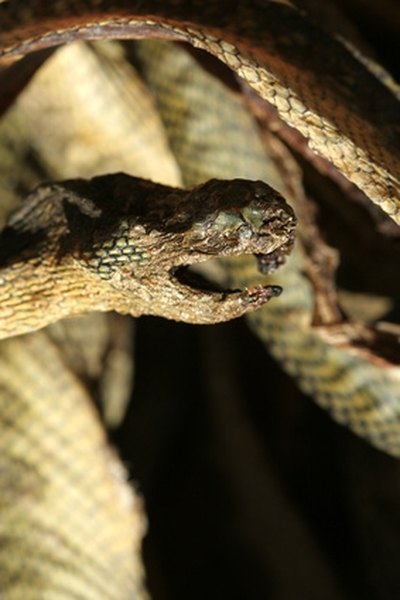
Snake gaiters are worn to protect the lower legs from potential snake bites. The purpose of using snake gaiters is to eliminate any vulnerable areas on the lower legs by protecting the legs with wrap-around, waterproof, puncture-resistant fabric coverings. This fabric is available at fabric stores and also at some hunting supply stores. Sewing gaiters ensures a custom fit instead of relying on generic gaiters. Creating gaiters with elastic casings along the top and bottom edges also ensures a snug fit.
Items you will need
Tape measure
Waterproof, puncture-resistant nylon fabric
Polyester batting (low loft)
Scissors
Straight pins
Sewing machine
Thread
1/2-inch-width elastic
2 safety pins
Sew-able hook and loop tape
Measure the distance from just below your knee to your ankle (where it meets the foot). Add 5 inches to the length measurement. This is the modified length measurement. Measure around the widest part of your lower leg and add 2 inches. This is the modified width.
Cut out 4 rectangles of waterproof, puncture-resistant nylon fabric according to the modified length and modified width measurements. Cut out 2 rectangles, according to the same measurements, from low-loft polyester batting. You will make one gaiter at a time.
Place one nylon rectangle with the right side of the fabric facing up. Place another nylon rectangle on top of the first with the wrong side of the fabric facing up. Place one batting rectangle on top of the nylon rectangle. When you sew the three layers together and turn them right-side out, the batting layer will be inside of the two nylon rectangles. Pin along the left and right sides and the top of the layers.
Sew along the pinned edges using a 1/2-inch seam allowance and a straight stitch. Remove the pins. Turn the gaiter right-side out through the open bottom. Fold the nylon fabric edges over 1 inch inside. Pin the edges. Sew horizontally along the bottom edge using a straight stitch and a 1/2-inch seam allowance. Remove the pins.
Fold the top edge over 1 inch and pin it. This is the casing for the elastic. A casing is a tunnel in which elastic is fed to form an elastic cuff. Fold the bottom edge up and over 1 inch against the same side of the gaiter that you folded the top edge. This side of the gaiter will now be the inside of the gaiter. Pin the edge.
Sew the top edge using a straight stitch and a 1-inch seam allowance. Remove the pins. Sew the bottom edge using a straight stitch and 1-inch seam allowance. Remove the pins.
Bend your knee. Measure the distance around the bend of the knee and directly below the knee cap. Cut out a piece of elastic that is three-quarters of this measurement. Connect a safety pin to one elastic end. Connect a safety pin to the other elastic end and to one opening of the top gaiter casing. Feed the elastic/pin through the casing until it emerges from the other opening. Remove the safety pins and sew the two elastic ends together. Sew the casing openings closed using a straight stitch on the sewing machine.
Measure the distance around your ankle. Cut out a piece of elastic that is three-quarters of this measurement. Repeat Step 7 to finish the elastic casing along the gaiter's bottom edge.
Measure and cut 2 pieces of hook and loop tape (1 hook tape and 1 loop tape) to fit the length of the sewn gaiter. Sew these strips vertically along the outer edge of the gaiter.
Align the hook tape vertically with the outer edge of the top-right edge of the gaiter and pin it to the gaiter. Sew around the hook tape using a wide zigzag stitch. Remove the pins. Align the loop tape vertically along the inside outer-left edge. Sew it to secure it. Place the gaiter around the lower leg, sticking the hook and loop tape together to close the gaiter.
Repeat Steps 1 to 10 to sew a second gaiter.
References
Writer Bio
Louise Harding holds a B.A. in English language arts and is a licensed teacher. Harding is a professional fiction writer. She is mother to four children, two adopted internationally, and has had small businesses involving sewing and crafting for children and the home. Harding's frugal domestic skills help readers save money around the home.



